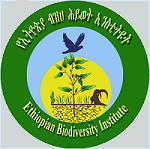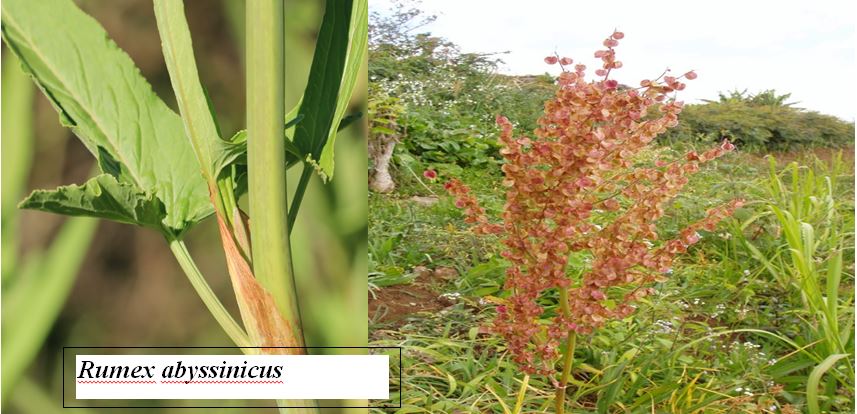 Bioprospecting Potential of Rumex abyssinicus for Access and Benefit Sharing
Bioprospecting Potential of Rumex abyssinicus for Access and Benefit Sharing
| Source | ABS |
|---|---|
| Release date | 07/07/2017 |
| Contributor | IT Team EBI |
| Geographical coverage | Rumex abyssinicus |
|
Bioprospecting Potential of Rumex abyssinicus for Access and Benefit Sharing
Reviewed by Tesfaye Bekele Genetic Resources Access and Benefit Sharing Directorate June, 2016 |
| 1. Introduction Ethiopia is lucky to be gifted with rich biodiversity and traditional knowledge that could pioneer successful bioprospecting. However, like any other developing countries, Ethiopia lacks technical expertise and monetary resources to explore them significantly. The only option for Ethiopia is to collaborate with the developed nations or domestic investors and interested pharmaceutical, cosmetics and other companies alike and jointly explore them strategically and wisely. In doing so, the model of cooperation should be such that it builds the science infrastructure within, preserve and protect the local traditional medicinal and other knowledge reducing the brain drain, and equally share the outcome of the joint projects. The Ethiopian Biodiversity Institute (EBI) is the nationwide capable authority through ABS directorate playing the practical role of the Nagoya Protocol on Access and Benefit-sharing of genetic resources and associated traditional knowledge. Ethiopia has the officially permitted outline for the implementation of the ABS. The laws concerning the National Access and Benefit Sharing framework is the Proclamation on Access to Genetic Resources and Community Knowledge and Community Rights (Proclamation No 482/2006 and Regulation 169/2009). Based on these frameworks, the country has been implementing the access and benefit-sharing objective of the CBD. The Proclamation includes a range of issues such as ownership, user rights, and conditions for access, benefit sharing, types of benefits, powers and responsibilities among the others. Therefore, the objective of this manuscript is to encourage any bioprospecting company or an individual interested to work on the genetic resource, Rumex abyss incus Jacq., for biological, pharmacological and industrial activities. 2. Plant descriptionRumex abyssinicus is perennial herb, which grows up to 3 m tall, with thick, fleshy rhizome. Its local Amharic name is ‘Mekmako’ (Ermias Dagne, 2009). 3. Habitat and distribution Rumex abyssinicus is widely spread in the highlands of tropical Africa. It is widespread throughout Ethiopia at altitudes between 1200 and 3300 m. It is a common and tolerated weed in fields and plantations. It also occurs along paths and water, in the secondary scrub, grassland and margins of rain forest. This plant species will remain locally an important vegetable from the wild (Edwards et al., 2000). 4. Significance Rumex abyssinicus is a potential genetic resource for bioprospecting due to its active parts rhizome, roots and leaves. The plant is used in treating various diseases. The decoction of leaf or root powder is taken as a vermifuge. Root powder paste with lime juice can be applied for infestation of Tinea nigra, T. versicolor. If eaten in large quantities, the plant could produce toxic effect due to its oxalate contents (Raju and Elias Ali, 2010).
4.1. Medicinal valueTeshale Mekonnen et al. (2010) reported that 80 % methanol extract of the rhizomes of Rumex abyssinicus possesses secondary metabolites such as tannins, saponins, flavonoids, steroids and anthraquinones. Flavonoids and tannins have been shown to be important for wound healing due to their antioxidant, anti-inflammatory and antibacterial activities. Rumex abyssinicus is used to treat malaria, gonorrhea, poisoning, hepatitis, constipation, sciatic neuralgia, hypertension, migraine, rheumatism, breast cancer, stomach distention, earache, liver diseases, hemorrhoids, typhus, rabies and wound (Teshale Mekonnen et al., 2010; Tilahun Teklehaymanot et al., 2007).
4.1.1. Anti-hypertensive, Anti-inflammatory, diuretic and analgesic The roots of Rumex abyssinicus are reported to exhibit anti-inflammatory activities (Getie et al., 2003). It has been traditionally used for management of hypertension, inflammatory and painful conditions in Ethiopia and also shows diuretic and analgesic activities (Teshale Mekonnen et al., 2010). It contains a number of anthraquinones that showed COX-2 inhibitory (non-steroidal anti-inflammatory drug that directly targets cyclooxygenase-2, an enzyme responsible for inflammation and pain), and antitumor activity against different cancer cell lines (Biniyam Girma et al., 2015). The roots are reported to possess anti-inflammatory activity against the synthesis of prostaglandin. 4.1.2 Anti-microbial Rumex abyssinicus roots were used for anti-microbial activities. The roots are reported to possess antibacterial activity against Streptococcus pyogenes. The plant has strong antiviral activity against Coxsackie virus and influenza A virus. In vitro it demonstrated proliferation of murine macrophage cells, suggesting that it may have a role in improving the immune system of the body (Diallo et al., 1990). It also contains promising bioactive compounds that might be useful in the control of helminth infections by interrupting the worms’ life cycle and preventing their growth (Basha et al., 2011).
4.1.3. Wound healing Eshetu Mulisa et al. (2015) reported that Rumex abyssinicus has a potential application as a wound healing agent. Higher hydroxyproline content in the extract and standard treated group might be related to the enhancement of the proliferation and migration of fibroblasts and collagen deposition. Better efficacy of the crude extract in wound healing was further evidenced by the breaking strength in incision wounds. The plant, when applied externally, is used fresh or dried to treat wounds, sores and parts affected by scabies (Bussmann et al., 2011). 5.1. Other UsesRumex abyssinicus has a yellow and a red dye as a result of its rhizome. It is used for colouring wickerwork, and to impart a red colour to the feet and hands of women. The crushed plants are used to clean cooking pots that have been blackened over the fire, and to remove grease. Leaves of various Rumex species are very good at removing dirty oil from the skin by simply crushing the leaves to release the sap and rub them over the dirty area (Bussmann et al., 2011).
Extract results showed that the curing system using 10% Rumex abyssinicus powder with 15% common salt is efficient in preserving the raw goatskins. Shegaw Ahmed et al. (2011) reported that the less-salt preservation system based on Rumex abyssinicus is a cleaner alternative for the conventional salt-based preservation method.
References Basha, S.N., Rekha, R., Sirak Saleh and Samuel Yemane (2011). Evaluation of in vitro anthelmintic activities of Brassica nigra, Ocimum basilicum and Rumex abyssinicus. Pharmacognosy Journal 3(2):88-92. Biniyam Girma, Getnet Yimer and Eyasu Makonnen (2015). Effect of Rumex abyssinicus on preneoplastic lesions in dimethylhydrazine induced colon carcinogenesis in rats. Complementary and Alternative Medicine 15:365. Bussmann, R.W., Swartzinsky, P., Aserat Worede and Evangelista, P. (2011). Plant use in Odo-Bulu and Demaro, Bale region, Ethiopia. Journal of Ethnobiology and Ethnomedicine 7:28. Diallo, D., Hveem, B, Mahmoud, M.A., Betge, G., Paulsen, B.S. and Maiga, A. (1990). An ethnobotanical survey of herbal drugs of Gourma district, Mali. Pharm. Biol. 37:80-91. Edwards, S., Mesfin Tadesse, Sebsebe Demissew and Hedberg, I. (2000) (Eds.). Flora of Ethiopia and Eritrea. Vol. 2 Part 1. Addis Ababa University and Uppsala University, Uppsala. Ermias Dagne (2009). Natural Database for Africa (NDA). Addis Ababa, Ethiopia, Version 1.0. Eshetu Mulisa, Kaleab Asres and Ephrem Engidawork (2015). Evaluation of wound healing and anti-inflammatory activity of the rhizomes of Rumex abyssinicus J. (Polygonaceae) in mice. Complementary and Alternative Medicine 15:341. Getie, M., Gebre-Mariam, T., Rietz, R. Höhne, C., Huschaka, C. and Schmditke, M. (2003). Evaluation of the antimicrobial and anti-inflammatory activities of the medicinal plants Dodonaea viscosa, Rumex nervosus and Rumex abyssinicus. Fitoterapia 74:139–143. Raju, N.J. and Elias Ali (2010). Evaluation of anthelmintic activities of Rumex Abyssinicus Jacq. and Rumex Nervosus Vahl. (Polygonaceae). International Journal of Pharmaceutical Sciences Review and Research 5(2): 43-48. Shegaw Ahmed, Balaraman Madhan, Berhanu Assefa, Brindha Velappan and Alagumuthu Tamil Selvi (2011). Rumex abyssinicus (“Mekmeko”) Ethiopian plant material for preservation of goatskins: Approach for cleaner leather manufacture. Journal of Cleaner Production 133:1043–1052. Teshale Mekonnen, Kelbesa Urga and Ephrem Engidawork (2010). Evaluation of the diuretic and analgesic activities of the rhizomes of Rumex abyssinicus J. in mice. J. Ethnopharmacol 127:433–439. Tilahun Teklehaymanot, Mirutse Giday, Girmay Medhin and Yalemtshay Mekonnen (2007). Knowledge and use of medicinal plants by people around Debre Libanos monastery in Ethiopia. J. Ethnopharmacol. 111:271–283. |
Please note that this information has expired.

